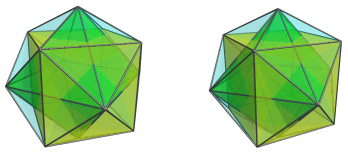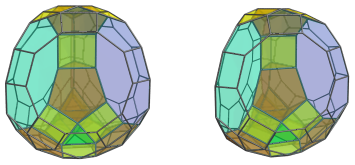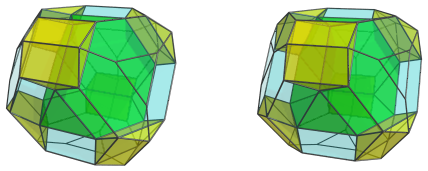4D Euclidean space
News Archive
Mar 2019
In February 2018, we introduced the tetrahedral ursachoron, a polychoron that consists of 4 tridiminished icosahedra (J63) folded in tetrahedral formation around a tetrahedral cell. This month, we introduce its big cousin, a polytope that consists of 4 tridiminished rhombicosidodecahedra (J83) folded in tetrahedral formation around a cuboctahedral cell:
This is the tetrahedral magnaursachoron, an interesting CRF polychoron that consists of 4 J83 cells, 8 J63 cells, 6 metabidiminished icosahedra (J62), 34 triangular prisms, 4 triangular cupolae (J3), 5 cuboctahedra, and one truncated tetrahedron.
It bears many parallels with J83 itself: just as J83 has 3 decagons folded around a framework of alternating triangles and squares, so the magnaursachoron has 4 J83 cells folded around a framework of J63 cells and cuboctahedra alternating with triangular prisms.
Find out more about the structure of this interesting polytope on the tetrahedral magnaursachoron page, which comes with its full algebraic coordinates, as always.
22 Mar 2019:
- Added the parabigyrate rhombicosidodecahedron (J73), the 73rd Johnson solid.
19 Mar 2019:
- Added the gyrate rhombicosidodecahedron (J72), another Johnson solid.
18 Mar 2019:
- Added the parabidiminished rhombicosidodecahedron (J80), yet another Johnson solid.
- Much less scary-looking representation of the coordinates of the disphenocingulum (J90).
- Less scary-looking representation of the coordinates of the snub square antiprism (J85).
17 Mar 2019:
- Added the diminished rhombicosidodecahedron (J76), another of the Johnson solids.
13 Mar 2019:
New set of coordinates for the snub cube with edge length 2.
12 Mar 2019:
Added more Johnson solids:
11 Mar 2019:
Added the augmented sphenocorona (J87), the 87th Johnson solids.
8 Mar 2019:
Added the sphenomegacorona (J88), one of the elementary Johnson solids that are not derived by cut-n-paste operations from the uniform 3D polyhedra.
Added the hebesphenomegacorona (J89), another of the elementary Johnson solids.
Full coordinates are provided for both of these rare solids in algebraic form, from which arbitrarily precise coordinate values may be computed.
Added the gyrate bidiminished rhombicosidodecahedron (J82), yet another Johnson solid.
7 Mar 2019:
Added the parabiaugmented truncated dodecahedron (J69), one of the Johnson solids.
Corrected an error in the coordinates of the augmented truncated dodecahedron (J68).
1 Mar 2019:
The Polytope of the Month for March is up!
February 2019
This month, we introduce the augmented cantitruncated 5-cell, an augmentation of the uniform cantitruncated 5-cell by a tetrahedral canticupola (K4.76):
This particular polychoron is notable because 6 of the triangular prisms of the cantitruncated 5-cell lie on the same hyperplane as the 6 triangular prisms of the augment in gyrated orientation, and therefore merge into gyrobifastigium (J26) cells.
Head over to the augmented cantitruncated 5-cell page to learn more about the structure of this interesting polytope with its unusual gyrobifastigium cells. We provide full coordinates as usual.
25 Feb 2019:
Added the augmented truncated dodecahedron (J68), one of the Johnson solids. As usual, we provide full algebraic coordinates for it.
1 Feb 2019:
The Polytope of the Month for February is up!
January 2019
In generalizing 3D polyhedra to 4D, a question that frequently crops up is how to generalize the 3D antiprisms. The common understanding of a 3D antiprism—two polygons in parallel planes rotated relative to each other and connected by triangles—is difficult to generalize to higher dimensions in a consistent way that is also aesthetically-pleasing.
A different way of understanding a 3D antiprism is that the top and bottom
polygons are duals of each other. Since the dual operation
applies across all dimensions, and furthermore preserves the symmetries of the
starting polytope, this provides a nice basis on which to construct a
higher-dimensional definition of an antiprism. Under this analysis, the
triangles connecting the polygons may be thought of as line pyramids
,
which become full-dimensioned pyramids in the higher-dimensional
generalization.

In the case of 4D, we can form a polyhedron antiprism by placing the polyhedron and its dual in parallel hyperplanes, and connecting the vertices of one to the faces of the other with polygonal pyramids, and vice versa. Furthermore, the edges of one can be connected to the other by tetrahedra. The image above shows one such example: the cube antiprism (K4.15), formed by placing a cube and an octahedron in two parallel hyperplanes and connecting them with 6 square pyramids and 20 tetrahedra, 8 of which connect the faces of the octahedron to the vertices of the cube, and 12 of which connect their respective edges.
For more details, go to the cube antiprism page and discover its structure, to learn how higher-dimensional antiprisms may be constructed. We provide full coordinates as usual.
Note: the above definition of a 4D antiprism is not compatible with the structure of the so-called Grand Antiprism, one of the uniform polychora. The grand antiprism has an interesting structure based on the Hopf fibration, which is peculiar to 4D and thus difficult to generalize to other dimensions. Furthermore, the grand antiprism stands alone as the only uniform (and indeed, the only CRF) member of its family. Nevertheless, its rings of antiprisms connected by tetrahedra do seem like a fitting analogue of the 3D antiprisms, so it possibly represents a different way to generalize the family of 3D antiprisms to higher dimensions.
25 Jan 2019:
An important internal rendering system upgrade took place today. You should not notice anything different about the site, but if you notice any images that have glitches, rendering artifacts, or that otherwise look wrong, please let us know. Thanks, and enjoy the site!
23 Jan 2019:
Added more Johnson solids:
21 Jan 2019:
Added the augmented truncated tetrahedron (J65), still another Johnson solid.
16 Jan 2019:
Added the augmented tridiminished icosahedron (J64), yet another Johnson solid.
15 Jan 2019:
Added the triaugmented dodecahedron (J61), another Johnson solid.
10 Jan 2019:
Added the metabiaugmented dodecahedron (J60), another of the Johnson solids.
9 Jan 2019:
The Polytope of the Month for January is up!






